Abstract
Somatic cell hybrids were prepared by fusing the AKR mouse lymphoma BW-5147 with splenic T cells from mice immunized with 4-hydroxy-3-nitrophenylacetic acid (NP) conjugated to chicken serum globulin (CG). From 500 fusion lines 11 were selected on the basis of binding radioiodinated NP-CG. The autoradiographic binding assay was based on previous findings which showed that Lyt-1+ T cells need a lymphokine, lymphocyte-activating factor (LAF), for optimal antigen binding and that they bind preferentially a self-Ia-associated antigen complex, IAC, which is released by adherent cells upon incubation with antigen. Six of the 11 antigen-binding positive lines were tested for helper activity and specific helper factor production in vitro. All of them were found to be positive. One clone was characterized in more detail. It secretes a CG-specific helper factor that contains immunoglobulin heavy chain variable region and I-A determinants. The hybridoma cells bind Ia-containing CG complexes specifically. For binding they need to be treated with LAF, and the binding is restricted to syngenicity in H-2 between the adherent cells used to produce IAC and the antigen-binding hybridoma cells. Regular CG does not bind significantly and does not compete even at high excess with the binding of CG-IAC. These data are interpreted to suggest that the antigen is bound by cells of a clone functional helper T-cell hybridoma line in conjunction with products controlled by H-2I and that the receptor of these cells may have considerably higher affinity for Ia-associated than for regular antigen.
Full text
PDF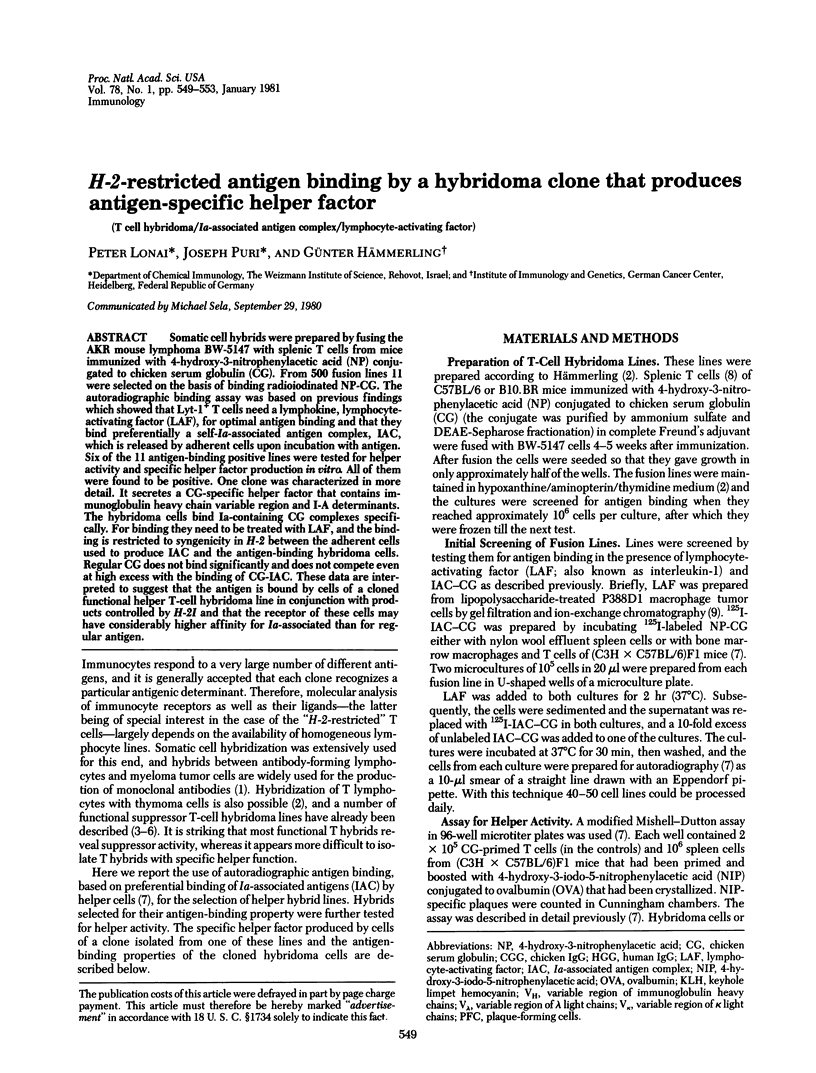
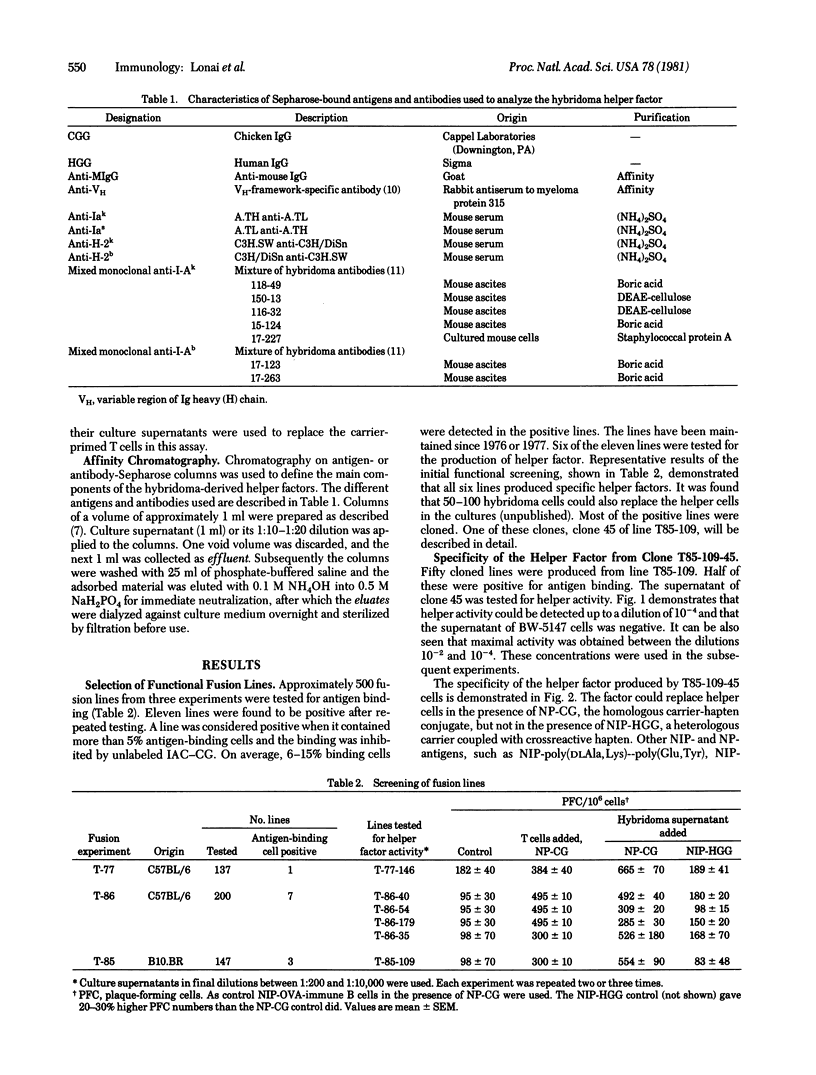
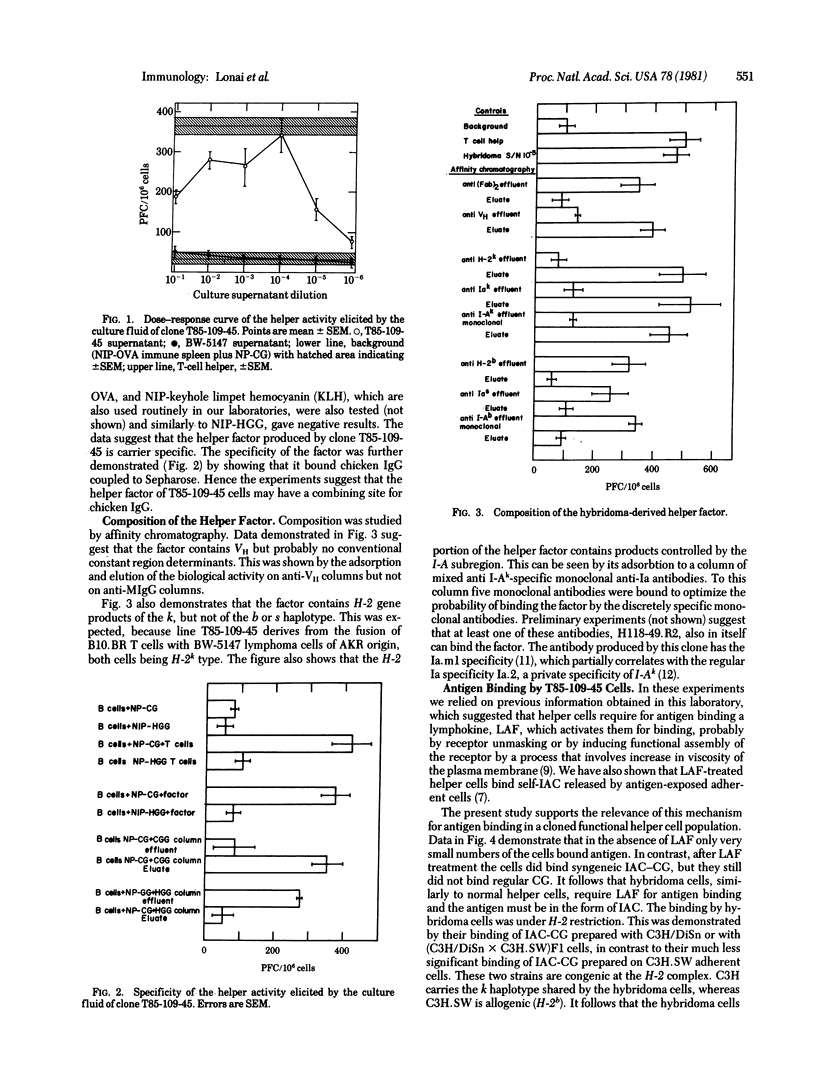
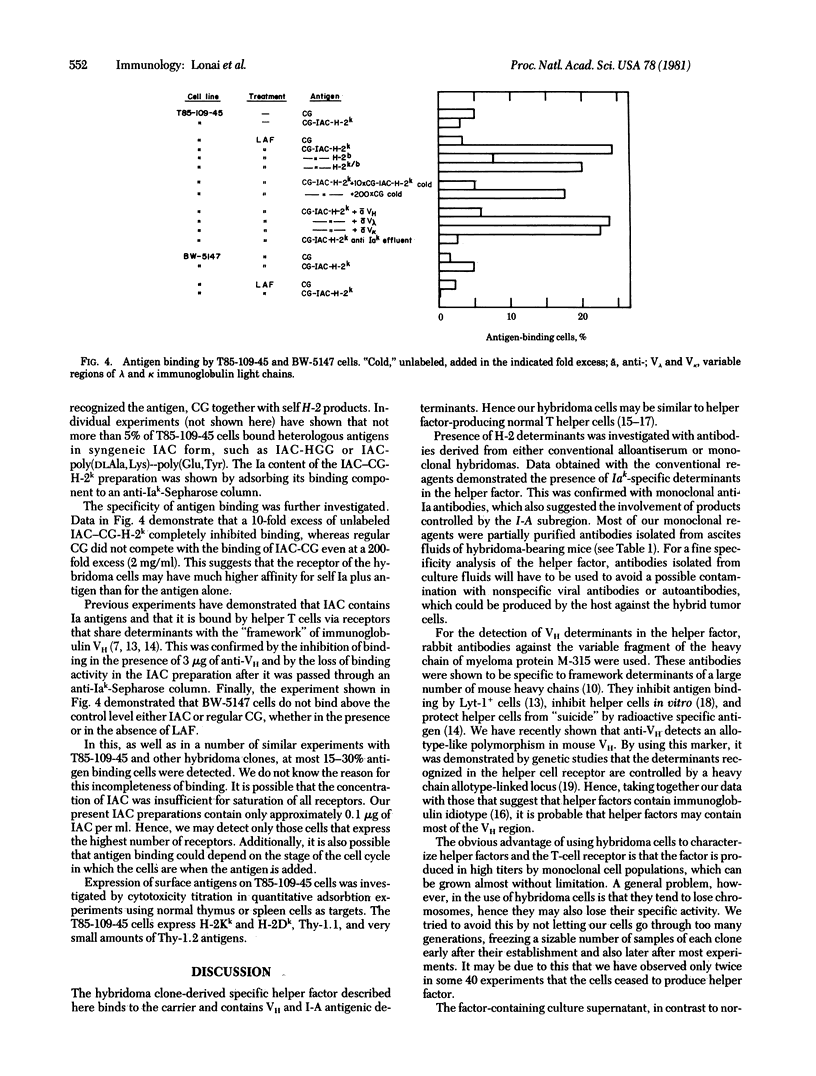
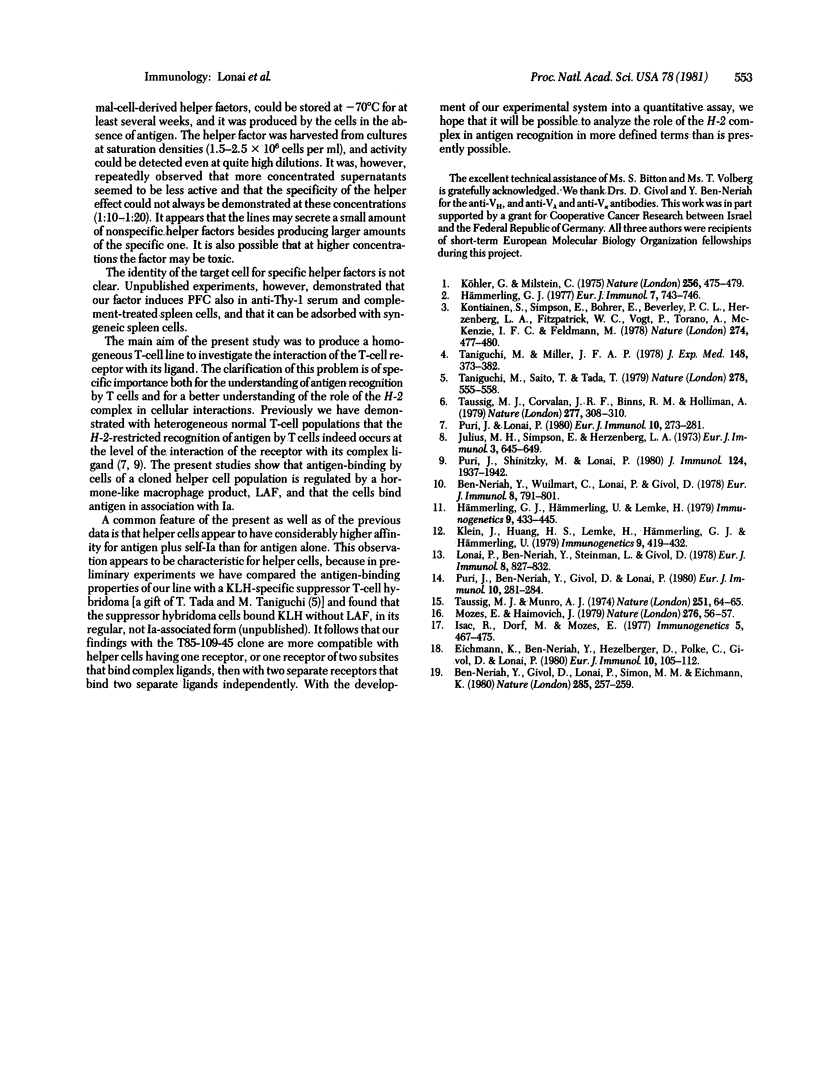
Selected References
These references are in PubMed. This may not be the complete list of references from this article.
- Ben-Neriah Y., Wuilmart C., Lonai P., Givol D. Preparation and characterization of anti-framework antibodies to the heavy chain variable region (VH) of mouse immunoglobulins. Eur J Immunol. 1978 Nov;8(11):797–801. doi: 10.1002/eji.1830081109. [DOI] [PubMed] [Google Scholar]
- Eichmann K., Ben-Neriah Y., Hetzelberger D., Polke C., Givol D., Lonai P. Correlated expression of VH framework and VH idiotypic determinants on T helper cells and on functionally undefined T cells binding group A streptococcal carbohydrate. Eur J Immunol. 1980 Feb;10(2):105–112. doi: 10.1002/eji.1830100207. [DOI] [PubMed] [Google Scholar]
- Hämmerling G. J. T lymphocyte tissue culture lines produced by cell hybridization. Eur J Immunol. 1977 Oct;7(10):743–746. doi: 10.1002/eji.1830071018. [DOI] [PubMed] [Google Scholar]
- Julius M. H., Simpson E., Herzenberg L. A. A rapid method for the isolation of functional thymus-derived murine lymphocytes. Eur J Immunol. 1973 Oct;3(10):645–649. doi: 10.1002/eji.1830031011. [DOI] [PubMed] [Google Scholar]
- Kontiainen S., Simpson E., Bohrer E., Beverley P. C., Herzenberg L. A., Fitzpatrick W. C., Vogt P., Torano A., McKenzie I. F., Feldmann M. T-cell lines producing antigen-specific suppressor factor. Nature. 1978 Aug 3;274(5670):477–480. doi: 10.1038/274477a0. [DOI] [PubMed] [Google Scholar]
- Lonai P., Ben-Neriah Y., Steinman L., Givol D. Selective participation of immunoglobulin V region and major histocompatibility complex products in antigen binding by T cells. Eur J Immunol. 1978 Dec;8(12):827–832. doi: 10.1002/eji.1830081202. [DOI] [PubMed] [Google Scholar]
- Mozes E., Haimovich J. Antigen specific T-cell helper factor cross reacts idiotypically with antibodies of the same specificity. Nature. 1979 Mar 1;278(5699):56–57. doi: 10.1038/278056a0. [DOI] [PubMed] [Google Scholar]
- Neriah Y. B., Givol D., Lonai P., Simon M. M., Eichmann K. Allotype-linked genetic control of a polymorphic VH framework framework determinant on mouse T-helper cell receptors. Nature. 1980 May 22;285(5762):257–259. doi: 10.1038/285257a0. [DOI] [PubMed] [Google Scholar]
- Puri J., Ben-Neriah Y., Givol D., Lonai P. Antibodies to immunoglobulin heavy chain variable regions protect helper cells from specific suicide by radiolabeled antigen. Eur J Immunol. 1980 Apr;10(4):281–284. doi: 10.1002/eji.1830100411. [DOI] [PubMed] [Google Scholar]
- Puri J., Lonai P. Mechanism of antigen binding by T cells. H-2(I-A)-restricted binding of antigen plus Ia by helper cells. Eur J Immunol. 1980 Apr;10(4):273–281. doi: 10.1002/eji.1830100410. [DOI] [PubMed] [Google Scholar]
- Puri J., Shinitzky M., Lonai P. Concomitant increase in antigen binding and in T cell membrane lipid viscosity induced by the lymphocyte-activating factor, LAF. J Immunol. 1980 Apr;124(4):1937–1942. [PubMed] [Google Scholar]
- Taniguchi M., Miller J. F. Specific suppressive factors produced by hybridomas derived from the fusion of enriched suppressor T cells and a T lymphoma cell line. J Exp Med. 1978 Aug 1;148(2):373–382. doi: 10.1084/jem.148.2.373. [DOI] [PMC free article] [PubMed] [Google Scholar]
- Taniguchi M., Saito T., Tada T. Antigen-specific suppressive factor produced by a transplantable I-J bearing T-cell hybridoma. Nature. 1979 Apr 5;278(5704):555–558. doi: 10.1038/278555a0. [DOI] [PubMed] [Google Scholar]
- Taussig M. J., Corvalan J. R., Binns R. M., Holliman A. Production of an H--2-related suppressor factor by a hybrid T-cell line. Nature. 1979 Jan 25;277(5694):305–308. doi: 10.1038/277305a0. [DOI] [PubMed] [Google Scholar]


